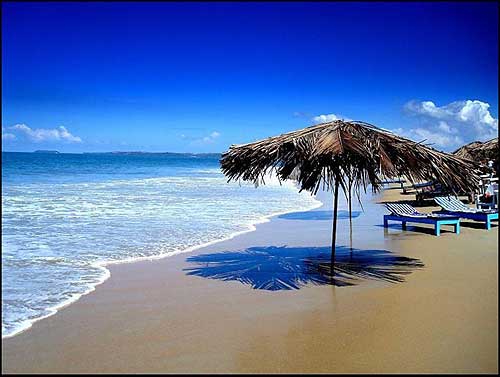|

Goa is India's smallest
state in terms of area and the fourth smallest in terms of
population. Located on the west coast of India in the region
known as the Konkan, it is bounded by the state of Maharashtra
to the north, and by Karnataka to the east and south, while
the Arabian Sea forms its western coast.
Panaji (also referred to as Panjim) is the state's capital.
Vasco da Gama (sometimes shortened to Vasco) is the largest
city. The historic city of Margao still exhibits the influence
of Portuguese culture. Portuguese first landed in Goa as
merchants, in the early 16th century, and conquered it soon
after. The Portuguese overseas territory existed for about 450
years, until it was annexed by India in 1961.[3][4]
Renowned for its beaches, places of worship and world heritage
architecture, Goa is visited by hundreds of thousands of
international and domestic tourists each year. It also has
rich flora and fauna, owing to its location on the Western
Ghats range, which is classified as a biodiversity hotspot.
Terekhol (Tiracol), Mandovi, Zuari, Chapora, Sal and Talpona
are the main rivers which weave their way throughout the state
forming the inland waterways adding beauty and romance to the
land besides being used to transport Goa's main export
commodity of Iron and Manganese ore to Mormugao Harbour. Along
the way to the coast these waterways form estuaries, creeks
and bays breaking the sandy, palm-fringed coastline behind
which lie the fishing villages among the coconut groves.
Panaji (Panjim) is the state capital located on the banks of
the Mandovi river and Vasco, Margao, Mapusa and Ponda are the
other major towns. Goa is serviced by an
international/national airport located at Dabolim near Vasco.
An intra-state and inter-state bus network also plays an
important role in getting locals and visitors alike in and
around Goa.
The vast green expanse of the Sahyadri mountain range ensures
that Goa has an abundance of water. The sea and rivers abound
in seafood - prawns, mackerels, sardines, crabs and lobsters
are the most popular with the locals and the visitors.
Along with English which is widely spoken all over Goa,
Konkani and Marathi are the state languages. The national
language Hindi is also well understood in most areas around
the state. Goan cuisine is a blend of different influences the
Goans had to endure during the centuries. The staple food in
Goa is fish and rice, both among the Hindus and the Catholics.
Unlike the Christian food the Hindu Goan food is not strongly
influenced by the Portuguese cuisine.
Since the arrival of the Hippies in the sixties, Goa has been
a major destination on the itinerary of international and
domestic tourists.
The tourist season in Goa begins in late September and carries
on through early March. The weather in these months is usually
dry and pleasantly cool.
Then the weather gets fairly hot around May and by end of
June, Goa receives the full blast of the Indian monsoon with
sudden downpours and tropical thunderstorms. However it is
also during the monsoon that Goa is probably at its most
beautiful, with greenery sprouting all around.
|

